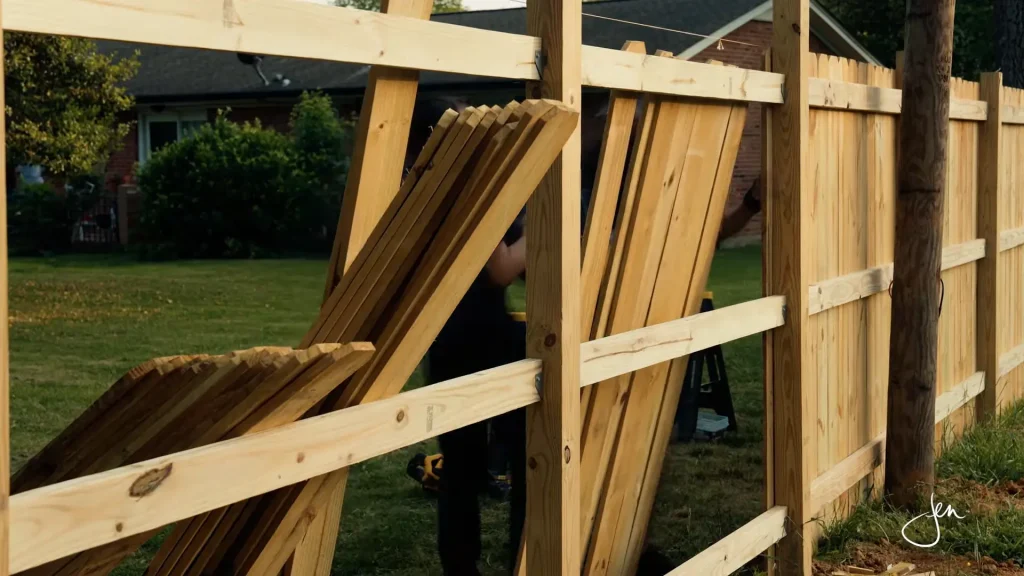How Long Does a Wood Fence Last? Lifespan & Maintenance Tips
Wood fences have long been a popular choice for homeowners seeking a combination of privacy, aesthetics, and durability.
They add a rustic charm to any property and can serve as a reliable barrier against unwanted intrusions. But if you’re considering installing a wood fence, or already have one, you might be wondering: “How long does a wood fence last?”
A well-maintained wood fence typically lasts between 15 to 20 years. The lifespan can vary based on factors such as wood type, climate, and maintenance practices. Using high-quality, treated wood and performing regular upkeep can extend its longevity.
In this blog post, we’ll dive into the factors that influence a wood fence’s longevity, share tips on how to extend its life, explore alternatives to wooden fences, and help you recognize when it’s time for a replacement. By the end, you’ll have a comprehensive understanding of what to expect from your wood fence and how to ensure it stands the test of time.
Lifespan of a Wood Fence

Generally, a well-maintained wood fence can last anywhere from 15 to 20 years. This lifespan can vary depending on several factors, such as the type of wood used, the quality of the installation, and the environmental conditions it’s exposed to.
For instance, cedar and redwood are renowned for their durability and resistance to decay, often outlasting other wood types like pine or spruce.
It’s important to note that while the initial investment in higher-quality wood may be greater, it can pay off in the long run with reduced maintenance costs and a longer lifespan.
On the other hand, untreated or low-quality wood might require more frequent repairs and replacements, ultimately leading to higher expenses over time.
Moreover, the longevity of a wood fence is also influenced by how well it’s cared for. Regular maintenance, such as cleaning, staining, and repairing any damage, plays a significant role in extending its life.
Factors Influencing the Lifespan of a Wood Fence
1 – Quality of Wood
The type and quality of wood you choose are primary factors in determining the lifespan of your fence. Cedar and redwood, for example, contain natural oils that make them resistant to rot and insect damage.
These woods can last significantly longer than untreated pine or spruce, which are more susceptible to decay and pests.
2 – Treatment and Preservation
Wood treatment and preservation methods also greatly impact durability. Pressure-treated wood, for instance, is infused with preservatives to help protect it from rot, decay, and insect damage.
This treatment can significantly extend the life of your fence compared to untreated wood. Regular applications of sealant or stain can further protect the wood from moisture and UV damage.
3 – Installation Quality
A properly installed fence is more likely to withstand the test of time. Ensuring that posts are set deep enough and using high-quality hardware can prevent structural issues down the line.
Hiring a professional for installation can often result in a sturdier, more durable fence compared to a DIY approach.
4 – Climate and Weather Conditions
The environment your fence is exposed to can either shorten or extend its life. Areas with high humidity, heavy rainfall, or extreme temperatures can cause wood to warp, crack, or rot more quickly.
Conversely, fences in milder climates with less extreme weather conditions often last longer.
5 – Soil Conditions
Soil quality and type also affect the lifespan of your fence. Sandy or well-drained soils are generally better for wood fences than clay or waterlogged soils, which can accelerate rot. Installing gravel boards and ensuring proper drainage can help mitigate these issues.
6 – Maintenance Practices
Regular maintenance is key to prolonging the life of your wood fence. Without proper care, even the best quality wood will deteriorate more quickly. Routine inspections, cleaning, and timely repairs can make a significant difference in your fence’s longevity, as we’ll discuss in more detail in the next section.
Maintenance Tips for Prolonging the Life of a Wood Fence
1 – Regular Inspections
Conducting regular inspections is crucial for catching small issues before they become major problems. Look for signs of rot, insect damage, and structural weaknesses.
Pay particular attention to areas where the fence meets the ground, as these are most susceptible to moisture damage.
2 – Cleaning and Staining
Keeping your wood fence clean helps prevent mold, mildew, and dirt buildup, which can contribute to wood decay.
A simple mixture of water and mild detergent can be used to scrub the fence clean. After cleaning, applying a stain or sealant adds a protective layer against moisture and UV damage.
This should be done every few years, depending on the product used and the local climate.
3 – Repairing Damage
Addressing damage promptly can prevent further deterioration. Replace broken or rotting boards and tighten any loose screws or nails.
For minor rot, you can use a wood filler or epoxy to fill in damaged areas. For more extensive damage, consider replacing affected sections to maintain the integrity of the fence.
4 – Protective Measures
Installing protective elements like gravel boards at the base of your fence can help prevent direct contact with soil and moisture.
Fence caps can protect the tops of the posts from water infiltration. Additionally, trimming back vegetation that touches the fence can reduce moisture retention and limit damage from overgrowth.
Alternatives to a Wooden Fence
While wood fences offer a classic look and feel, they may not be the best option for everyone. Let’s explore some popular alternatives that might better suit your needs.
Vinyl Fences: Durable and low maintenance, resistant to rot, insects, and weather, with higher initial cost but long-term savings.
Metal Fences: Strong and long-lasting, resistant to rot and insects, with occasional painting needed to prevent rust.
Composite Fences: Combines wood fibers and plastic for a wood-like appearance, resistant to rot, insects, and weather, but more costly than traditional wood.
Cost vs. Longevity Analysis: Alternatives like vinyl, metal, and composite have higher upfront costs but offer long-term savings due to durability and low maintenance.
Signs That It’s Time to Replace Your Wood Fence
Structural Weakness: When your wood fence starts leaning, sagging, or develops loose posts, it’s a clear indication that replacement may be necessary. While minor issues can be fixed, extensive structural damage often requires a full replacement to maintain stability and security.
Extensive Rot or Insect Damage: Widespread rot or significant insect damage compromises a wood fence’s integrity, necessitating replacement. Small repairs may temporarily address the issue, but extensive damage undermines the fence’s reliability and longevity, making replacement the best long-term solution.
Aesthetic Decline: As wood fences age, they can deteriorate in appearance despite regular maintenance. If your fence shows noticeable discoloration, warping, or splintering that cleaning or staining can’t improve, it’s likely time to consider replacing it to restore both appearance and function.
Safety Concerns: A fence that’s in poor condition can pose safety risks, especially if you have children or pets. Sharp splinters, protruding nails, and unstable sections are all hazards that can be avoided by replacing the fence.
Conclusion
In conclusion, the lifespan of a wood fence can vary widely based on factors like wood quality, treatment, installation, and maintenance. While a typical wood fence might last 15 to 20 years, proactive care and regular upkeep can extend its life significantly. Understanding these factors and taking steps to maintain your fence can help you enjoy its benefits for many years.
Exploring alternatives to wood fences can also provide valuable insights into the best option for your property. Whether you choose vinyl, metal, or composite, each material offers unique advantages and considerations.
Ultimately, knowing when to repair or replace your fence is crucial for ensuring it remains functional and aesthetically pleasing. By staying vigilant and addressing issues promptly, you can maintain the beauty and security of your property.
Remember, a well-maintained fence not only enhances your home’s curb appeal but also provides a sense of privacy and security. So, whether you’re looking to install a new fence or care for an existing one, these tips and insights will help you make informed decisions and keep your fence in top shape for years to come.
Related Articles:

